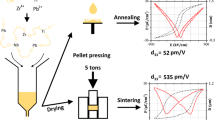Abstract
The “aging” characteristics of an acetic acid/methanol solvent-based lead zirconate titanate (PZT) precursor solution, prepared by the Inverted Mixing Order (IMO) process, have been studied for an extended period of time. The changes in film properties were characterized using optical microscopy, optical scattering, and ferroelectric testing. Films generated from the IMO process exhibit an increase in thickness as a function of solution age due to chemical “aging” (esterification) of the precursor solution. This increased thickness results in a decrease in the microstructural uniformity, which affects the electrical and optical properties. In order to understand and eventually control this phenomenon, we have quantified the “aging” of this solution using a variety of analytical methods, including 1H NMR spectroscopy, pH measurements, and Fourier transform infrared (FTIR) spectroscopy. It is of note that we have discovered a method that circumvents this “aging” problem by removal of the volatile material, forming an IMO powder which can be redissolved to produce high quality PZT thin films whenever desired.
Similar content being viewed by others
References
G. Wi, Z. Wu, and M. Sayer, J. Appl. Phys. 64, 2717 (1988).
K. D. Budd, S. K. Dey, and D. A. Payne, Brit. Ceram. Soc. Proc. 36, 107 (1985).
J. Fukushima, K. Kodaira, and T. Marsushita, J. Mater. Sci. 19, 595 (1984).
G. H. Haertling, Ferroelectrics 116, 51 (1991).
R. W. Schwartz, R. A. Assink, and T. J. Headley, in Ferroelectric Thin Films II, edited by A. I. Kingon, E. R. Myers, and B. Tuttle (Mater. Res. Soc. Symp. Proc. 243, Pittsburgh, PA, 1992), 245.
R. W. Vest and J. Xu, Ferroelectrics 93, 21 (1989).
R. A. Assink and R. W. Schwartz, Chem. Mater. 5, 511 (1993).
B. A. Tuttle and R. W. Schwartz, Mater. Res. Soc. Bull. 21, 49 (1996).
T. J. Boyle, T. M. Alam, W. L. Warren, M. M. Rosay, and C. D. Buchheit, unpublished.
S. Doeuff, Y. Dromzee, F. Taullele, and C. Sanchez, Inorg. Chem. 28, 4439 (1989).
S. Prabakar, R. A. Assink, N. K. Raman, and C. J. Brinker, in Better Ceramics Through Chemistry VI, edited by A. K. Cheetham, C. J. Brinker, M. L. Mecartney, and C. Sanchez (Mater. Res. Soc. Symp. Proc. 346, Pittsburgh, PA, 1994), 979.
T. J. Boyle, R. W. Schwartz, R. J. Doedens, and J. W. Ziller, Inorg. Chem. 34, 1110 (1995).
M. Sinclair, D. Dimos, B. G. Potter, R. W. Schwartz, and C. D. Buchheit, Int. Ferroelectrics 11, 25 (1995).
B. G. Potter, M. B. Sinclair, and D. Dimos, Appl. Phys. Lett. 63, 2180 (1993).
M. B. Sinclair, D. B. Dimos, B. G. Potter, and R. W. Schwartz, J. Am. Ceram. Soc. 78, 2027 (1995).
R. W. Schwartz, J. A. Voigt, B. A. Tuttle, D. A. Payne, T. L. Reichert, and R. S. DaSalla, J. Mater. Res. 12, 444 (1997).
M. J. Lefevre, J. S. Speck, R. W. Schwartz, D. Dimos, and S. J. Lockwood, J. Mater. Res. 11, 2076 (1996).
A crystal of {[Pb(O2CMe)2•py]2}∞ was isolated from an IMO mixture which had pyridine added to aid in crystallization. {[Pb(O2CMe)2•py]2}∞ was solved in the P21/n space group with a = 9.039 (1) A, b = 10.196 (1), c = 24.970 (2), ß = 99.13°, and V = 2272(1) Å3 for Z = 4. Full details will be reported shortly. The ease of crystallization and high yield implies that the Pb component of the IMO was not intimately mixed with the Ti/Zr alkoxides.
V. W. Day, T. A. Eberspacher, Y. Chen, J. Hao, and W. G. Klemperer, Inorganica Chim. Acta 229, 391 (1995).
Final film properties and precursor structures have been found to be influenced by ester formation. C. D. E. Lakeman, M. S. Thesis, University of Illinois (1991).
W. L. Masterton and E. J. Slowinski, Chemical Principles (W. B. Saunders Co., Philadelphia PA, 1977), pp. 448–450.
A patent application (Sandia reference number SD-5548) has been filed on this technique.
D. C. Bradley, R. C. Mehrotra, and D. P. Gaur, Metal Alkoxides (Academic Press, New York, 1978), pp. 117–122.
Personal communication with S. J. Lockwood of Sandia National Laboratories.
M. Toyoda, Y. Hamaji, K. Tomono, and D. A. Payne, Jpn. J. Appl. Phys., Part I 32, 4158 (1993).
Author information
Authors and Affiliations
Rights and permissions
About this article
Cite this article
Boyle, T.J., Dimos, D., Schwartz, R.W. et al. Aging characteristics of a hybrid sol-gel Pb(Zr, Ti)O3 precursor solution. Journal of Materials Research 12, 1022–1030 (1997). https://doi.org/10.1557/JMR.1997.0143
Received:
Accepted:
Published:
Issue Date:
DOI: https://doi.org/10.1557/JMR.1997.0143




